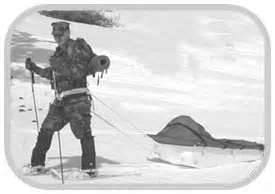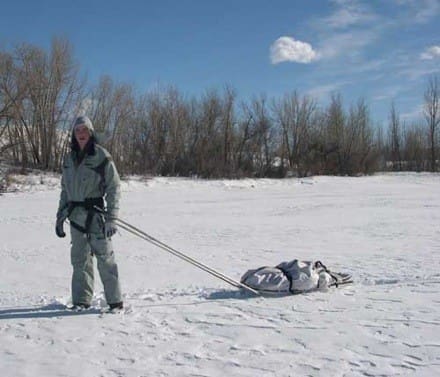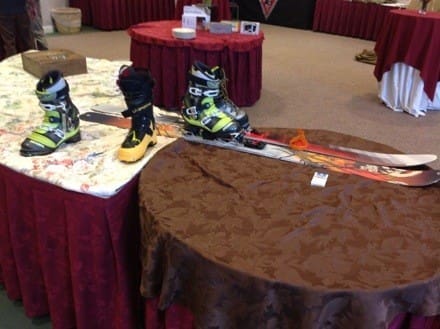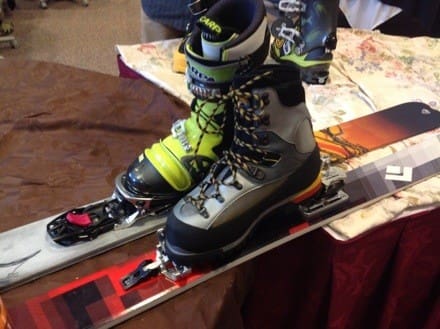The discussion began with a focus on sleds. Traditionally called Ahkios or Pulkas by the US military, the issue model dates from at least the 50s and is pretty big. Small unit operations call for a smaller model and the USMC is now using a model by Wilderness Engineering. The Marine Corps – Large Transport and Rescue Sled or MC-LTRS weighs about 32 lbs.
Kifaru also offers a sled called the Combat Expedition Sled which is 15 lbs as well as a smaller Combat Armadillo at 12 lbs.
Next, the group discussed skis. Granted, snow shoes are much easier to train troops to use but skis are much more useful for military operations than snow shoes. The increase in mobility is tremendous. And, because the skis will always have climbing skins, they won’t end up being all that fast in the down hill so they are more controllable than you might think. Additionally, little military skiing is downhill but rather as a means to transit from area to another.
Additionally, an interesting point that came out regarding the military’s mindset regarding NATO bindings. Modern commercial boots and bindings are way ahead of low leather boots. In fact, New plastic boots are very flexible. While the military procurement system might not purchase boots that fit every single foot type, there are things that can be done to help with fit including thermo molding of liners. The issue isn’t the boots, once you come to grips with using a single plastic, two-piece boot, but rather the bindings. New bindings like the NTN and Tech bindings are designed specifically for these new boots and are easy to get in and out of. The Dynafit patent for the Tech Binding has sunset so anyone can now make them.
Tags: Kifaru, Wilderness Engineering






— Granted, snow shoes are much easier to train troops to use but skis are much more useful for military operations than snow shoes. The increase in mobility is tremendous. —
METTC. If you’re in thick undergrowth skis would definitely not increase your mobility.
Randonnée bindings might be nice. Pricey, but nice.
If your in thick undergrowth in snow you’re going to have mobility problems no matter what you have on your feet.
Thick bush hindering the usage of skis is much of a myth propelled by unexperienced skiers.
From the winter warfare manual of the Finnish Defence Forces, snowshoes are typically superior for mine laying and clearing operations, in cramped positions, as backup when transporting skis would be impractical.
Speaking of backups. The winter survival kit for fighter pilots include foldable skis.
A platoon of infantrymen with little to no experience on skis would be pretty funny to watch! However, a small recon team would greatly benefit from skis, as it uses a lot less energy compared to snowshoes.
Like everything else, skis require training, and their not for everybody.
Skis are for *every* soldier if serious about winter warfare. Infantry in particular. An infantry platoon without soldiers able to ski is a very bad platoon in winter. Think of an infantry platoon with men who couldn’t run in summer.
Interesting post. I know they are on skis while transiting but I gather from the post that the troop leaves the skins on the ski even if they need to move downhill. Is that right?
You can definitely downhill with skins on. They do slow your descent, but that is not necessarily a bad thing, especially if you are a crap skier like myself.
I’m amazed that the military is still using mountain / Arctic gear that was first issued in the ’50’s. We used that stuff when I did Arctic Warfare training at Fort Wainwright in 1985 – and it was totally antiquated then!
This sounds like a fascinating and fantastic event – wish I could have been there.
Randonee bindings would be the hot setup, or, alpine touring bindings. Flip them into “walk” mode and off to the races. Pulling a pulk, the skins act like an extra brake if navigating a slope. Amazing what can be climbed with skins on…
Down hill with skins on? Is this a joke? As an avid backcountry skier, skiing down a steep section with skins on is up there in the scariest moments I have had on skis. Talk about lack of control.
FWIW Scarpa has made Maestrales in all black with the 10th Group crest on them.
Plastic Ski boots are fantastic. Thats why no one skis in leather ski boots anymore. But god help you if your foot is significantly different in width and shape than the shell. Relying on custom liners will result in a lot of very very cold and sore feet. It is possible to modify the shell, but this is relatively time consuming and requires someone who is practiced at it.
Will. Custom boots are out of the question for large-scale military usage. How would you manage replacing boots for a unit deployed in field?
That said, the recreational backcountry skiing in the US is very much about downhill, and not so much about utility and transport in flatter arctic conditions. Standard rubber winter boots are relatively loose fitting felt lined laceless boots with soles compatible with standard bindings. These are very much unlike downhill skiing boots. I’m sure that a backcountry skiers would find the lack-of-control intimidating with these, Nato bindings and 250cm flexible forest skis without metal edges. In steep downhill, you just mustn’t go fast.
You are absolutely right that military skiing is not about downhill but NATO bindings are the real issue at hand. There’s no reason to continue to purchase them. Hell, companies don’t want to make them. They are outdated, more difficult to use and lead to more injuries.
I disagree on the Nato bindings. They are heavy, yes, but otherwise fine as general purpose ski bindings for field usage.
What comes to injuries, it’s of course true that they don’t offer anything like the high-speed control that dedicated downhill skis have. As they are not intended for fast descents, the need for autorelease is less. Common XC bindings don’t have proper autorelease either, despite the speed on groomed XC tracks is much higher than for which military bindings are designed for. Besides, autorelease is a mixed blessing. It leaves the bindings potentially unsuitable for some techniques useful in locally very steep conditions. This could be addressed with the design of the release funciton, though. This said, auto-release would probably have saved me from a knee operation…
A military utility binding needs to work with all issue (winter) footwear. Dedicated skiing-only boots is not acceptable for any larger scale usage, never mind boots and bindings requiring customization for each soldier. Any soldier must be able to change from skis to on-foot, and back, rapidly. And you can’t have spare footware and spare-skis requiring customization.
There are two ways to solve binding/footwear compatibility. 1) Make all (winter) footwear compatible with the standard bindings. This was the approach of the Finnish army with the m/56 bindings . 2) Make the bindings accept practically any footwear. This is the new approach by the Fin army, replacing the m/56, but also much like it was prior to m/56.
m/56 is very similar to Nato bindings, but lighter and lacking the width adjustment. As with Nato bindings, you can use footwear not designed for compatibility, it just doesn’t work that well. Also, you can quickly adjust it for different size footwear.
That was the point of the article. For years we have been held hostage by unsuitable boots that gave need to NATO bindings but those days are now over. The military can now have a suitable cold weather boot that will work in and out of skis, snow shoes and crampons as well as on the march and other mountaineering tasks. Along with these can come more advanced bindings.
I’d love to see more info on the Fin M/56 binding.
I’d be very reluctang about these hi-tech bindings. A military binding has to be very rugged and reliable. For example, how do the complex mechanism of these shiny bindings work when iced up? Say, dip your ski in creek at -20F. It’s tedious enough to scrap the ice from the ski bottoms.
Military ski bindings, like the Nato bindings, or their Swedish and Finnish (m/56) counterparts, are extremely simple, strong and reliable.
Not only the skis and the boots, but also the skis in the pic are very unlike common military skis. The colorful skis pictured wouldn’t work well in soft-snow condtions.
m5 – NEVER say you can’t use something because of color. The point is to get the military as an institution to change the requirement. Once they do that, companies will be happy to offer products in subdued colors. This goes for virtually any commodity. If someone will commit to a large enough quantity ou can get companies to change colors and features. Industry needs a demand to build something. That’s how business works.
If you close your mind to what’s possible based on what’s available, you’ll never improve.
The color was, of course, a trivial point. The issue with the skis pictured is that are recreational backcountry skis. Such skis prioritize downhill and mountain terrain, because that’s the popular part of skiing in the US. From a mobility point of view, downhill speed doesn’t matter much – down is fast anyway. Uphill and flat is where time is spent.
Backcountry mountaineering skis are designed for mountain terrain with hard-packed snow or snow with crust. But for soft snow conditions, they obviously lack the lenght necessary for 1) flotation and 2) sufficient vertical flex of the tip. The latter is also very useful in ‘rough’ (locally very uneven) terrain.
A few observations from my VERY short time as an instructor as the USMC Mountain Warfare Training Center. There are two types of ski set ups that we use.
1) 190/210cm Asnee cross country skis, with Vapor Barrier Boots. AKA “White Rockets” and NATO 120 bindings. These are for sure the lowest common denominator for skis.
2) Karhu skis with Targa G3 Ascent bindings, Black Diamond skins, and Garmont Excursion Ski March Boots. MUCH better.
In the space of 2 days, we can teach an entire rifle company to operate on skis, with the ability to perform basic flat ground and downhill techniques. Are they expert skiiers? Hell no. Can they get to the objective through some pretty tough terrain, with all of their equipment? Yup.
There are times you just can’t hold up a column long enough to remove skins in order to execute the downhill portion of your movement. Also, the majority of your troops are going to be so inexperienced that the drag of the skins is going to help them significantly when having to negotiate that terrain.
I’ll probably add more later, but the BLUF is that skis are a viable mode of transportation in mountainous, snow covered, complex terrain.
The Wilderness Engineering sleds are built with an interesting molecular chemistry making them extremely durable. They performed very well at Black Rapids last year at the NWTC Cold Weather and Mountaineering Symposium, The sleds hold up well even pulled across rock and capacity is extreme. They have even been used as boats from time to time.
Reading the accounts of the 10th Mountain Division from 1942 onward will give wonderful insights into Mountain and Cold Weather Operations, great read on a cold, snowy, and blowing night!
Besides Skis and Snowshoes some units are looking at a third mode of conveyance, I was surprised to see it work so well!
The other benefit that comes with pizza coupons is that locating them
is very easy. They have been helping grocery shoppers
save money since 1998. Fatwallet.